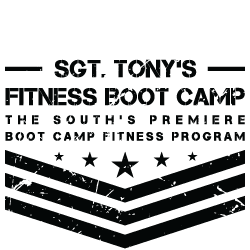Zuuto Tomodachi — Tony Ludlow, 3/22/2018
You have to try hard to avoid seeing published articles—almost daily—explaining the far-reaching benefits of exercise. Benefits that go beyond the physical! Toward that end …
APRIL IS BRING A FRIEND TO BOOT CAMP MONTH!
In honor of my friend, Tom Farrar, who passed away at the tender age of 54. Tom was my accountant and a great guy, but he did NOT take care of himself.
As an Air Force vet, he enjoyed chiding me for being a Marine 24/7 and always staying in shape. “All of that running around and sweaty exercise is good for you Marines, Tony,” he’d say, “I’m more of a fine wine and dining sorta fella!”
No matter what I said, I couldn’t convince my Type-A, overweight, high-strung friend to exercise and lose weight.
Tom had a heart attack and died in his front yard picking up his newspaper one morning in the spring of 2007. (He would have joked that The Commercial Appeal was responsible for his demise.)
Ever since Tom’s death, a death I believe was preventable, I’ve designated April as the “TOM FARRAR MEMORIAL BRING A FRIEND TO BOOT CAMP MONTH.”
• You can bring a friend for a week for free!
• No strings attached, no pressure to join!
• I won’t gather their contact info, and I won’t do anything but make them feel welcome!
• Absolutely no sales pitch, no guilt, and no veiled attempt to sign them up.
In fact, if they decide to continue after their free week with us, they’ll have to initiate that!
And I promise not to be mean to them!
You guys aren’t clients or members; you’re family and friends to me. So, thank you for your continued support. If the program has been beneficial to you, invite a friend to join you for a week, especially a sedentary friend. This isn’t really an invitation to people who are actively involved in some other all-inclusive fitness program. Sedentary people, people who only run or who only cycle are the kind of folks that I’m hoping we can reach!
Let them come and enjoy a week on the Quarterdeck at no charge!
If you no longer live in Memphis, but your friends and family are still here, send them to me for a FREE WEEK!
If you’re injured and unable to exercise with your friend, go ahead and send them to me. You don’t have to be with them. Your referral will be enough.
And if you need to get back on the Quarterdeck yourself, c’mon!
I promise NOT to guilt you or give you a hard time! I don’t care if you’ve gained weight or you’re out of shape. Don’t be embarrassed! I’m not going to shame you or make you feel bad. I’m always so happy to see you! You’ll be met with a hug or a hearty handshake and a “welcome home” reception!
Since I don’t advertise, you guys are my sales staff, so please share this post and tag your friends in the comments.
30
—————————————–
Patreon
Through the years—almost 19 now—folks have been super supportive of USMC Fitness Boot Camp and all that I do through it: lead 3 daily exercise classes, counsel members, lead half marathon training, write essays, and provide health, fitness, and nutrition counseling.
Weekly, I hear from former boot campers who’ve moved away. They write saying how significant the program was to them, how much they miss it, and how much they enjoy getting the newsletters and Facebook updates.
Some of those folks still live in Memphis but life and circumstances have “providentially” hindered them from coming back to the Quarterdeck, usually because they’ve moved out the city into the county.
Sometimes, those who’ve moved away send money because they want to be helpful and to support the program. This happened just a few days ago. Sometimes these folks know that at any point in time, there are about half a dozen boot campers coming for free because they lost their job, or there’s been some other detrimental change in their finances and they’d have to drop out boot camp.
We’re the only fitness company in Memphis that allows members to continue to participate for free if they lose their jobs or their finances take a horrible hit. And when they’re back on their feet, they just start paying from that point forward. The months they came for free never have to be paid back.
I consider what I do to be more ministry than business, and don’t kick anyone out because of money problems.
Like you, I support different causes and organizations in Memphis just because I believe in what they do and want to help them keep doing it. Monthly, I support 5 different local entities, including WKNO and Literacy Mid-South.
Additionally, last year I started supporting two different people on a site called Patreon. It’s a way to support artists, musicians, writers, instructors, and others who produce content of a broad nature, but might not be able to continue doing so without financial support from patrons … like how educators, artists, musicians, and others were supported by patrons back in the day.
I’ve been encouraged to join Patreon myself, giving folks an opportunity to support the program in small automatic monthly amounts.
Check out the page and if you feel led to support the work I do, even if it’s $1 a month, the number of patrons will be an encouragement to me and others!
https://www.patreon.com/TonyLudlow/overview
Thank you so much!
————————————
TODAY’S NUTRITION TALK
by First Sergeant Ashley Holloway, Registered Dietitian, LDN, MS.
(A Registered Dietitian has a BS in Food Science, followed by a one-year internship through an accredited university, and then with the recommendation of the internship program’s supervisor, a national examination is required. After that, an RD must have continuing education units annually in order to remain active and registered. An RD is an expert, not a hobbyist or a “food enthusiast.”)
Nutritional Science 101- Muscle Mania
In order to have the best physical health, we need to make sure that our bodies are packed with muscle. Muscle makes up about 75 percent of our lean body mass. Lean body mass also includes our organs, bones, tissue, and skin. It generates heat, and it serves as a pool of protein for our muscles and vital organs, and tissues. Muscle gives us mobility and balance and allows us to get up from a sitting position, to walk across the room, and to do all activities that we do in our daily lives.
The bad news is, the amount of muscle mass we have will decrease as we get older! And by older, I mean around 25-30 years of age. The reason we begin to lose muscle as we age is due to the slowdown of how our body uses the protein we eat to build muscle, called protein synthesis. By age 40, we can lose up to 8% of our muscle mass every ten years, and then around 70 years of age, this muscle loss can almost double to a 15% loss every ten years. That is a lot of muscle loss!
Another way we lose muscle is if we become ill or injured in some way. If our bodies are trying to fight off an illness or repair from an injury, it increases our need for calories and protein. And if we are unable to eat or consume enough protein for the healing process, our bodies will actually break our muscles down so that the protein can be used for healing. This muscle loss can happen very quickly and rapidly! If we are younger and have plenty of muscle, breaking down a little of our muscle may not be a big deal. But if we are older and are already losing muscle due to aging, the consequences can be devastating, and could also be life ending!
Losing just 10% of our muscle mass leads to decreased immunity and increased risk of infection. The more muscle mass we lose, the worse it is.
Losing muscle and lean body mass leads to:
♣ the inability to heal and recover from surgery, illness or disease
♣ Decreased strength and energy
♣ Loss of independence
♣ Increased risk of falls and fractures
♣ Weakened immune system and increased risk of infections
♣ Impaired healing
♣ Weakness/fatigue
♣ Increased susceptibility to illness
♣ Decreased quality of life
Sadly, when our body loses 40% or more of lean mass, it is incompatible with life, we die. Our body has become so weak, that it just can’t sustain itself any longer.
A person’s weight on the scale is not always a good indicator of muscle loss, especially in people who are overweight and obese. And obese person can be a skinny frail person on the inside, with just a lot of cushion on the outside. One of the best indicators for muscle loss is to look for changes in functional status, strength, and energy. Think about someone older in your life that you have known for a long time. Has their strength, stamina, energy level, or their ability to get around decreased? Is this YOU?
Now that I have sufficiently depressed you, let me tell you the good news! There are things we can do to counteract the natural loss of lean body mass as we age. We can’t slow down the loss completely, but we can slow it down considerably. We can avoid losing our independence, our functionality, our strength, and stamina by doing two key things.
The first key thing we can do (and should do) to maintain muscle mass is to do strength training exercises. You have probably heard the saying “If you don’t use it, you lose it.” Well, research shows that performing weight bearing exercises a minimum of 2-3 days a week does help to prevent muscle loss and build our muscle mass. These exercises don’t have to include heavy weights or even joining a gym, but each session should cover all the major muscle groups. Push-ups, sit-ups, wall squats, planks, lunges, and many other body weight exercises can be done to accomplish this goal.
The second thing we can/should do to prevent age-related muscle loss, it is recommended that we eat protein at least three to four times a day, consuming 20-30 grams at a time, for the highest muscle building rate. An average three-ounce portion of meat (about the size and thickness as the palm of your hand) contains a little over 20 grams of protein. The type of protein should be high-quality protein such as meat, milk, poultry, and fish. Nuts, seeds, legumes, and many other foods also contain protein to meet that 20-30 gram per meal goal.
Consuming plenty of protein is usually no problem at all when we are younger. But as we age, we typically eat a lot less protein. Why? The reasons can be numerous: taste changes, digestion issues, chewing problems, difficulty preparing meals, living solo, and many more reasons. As we age, we need to pay close attention to the amount of protein we eat and strive to take in enough to prevent the loss of our muscle and decreases in functionality, strength, and energy.
As you can see, muscle mass is extremely important and is vital for life. Strength training exercises and good nutrition play a key role in helping maintain and build lean body mass. Having healthy muscles equals a healthier, stronger, independent you!
Have you ever wondered how the protein we eat turns into muscle? When we eat eggs, turkey, beef, pork, and other sources of protein, your body uses about 8% of the calories from protein for muscle building and repair. Here is a simplified tutorial adapted from Men’s Health on how it all works.
Step 1-Digestion: When we eat protein, enzymes from your stomach and small intestine break down protein into smaller pieces called amino acids (the building blocks of protein) and peptides (which are chains of at least two or three amino acids.) More enzymes in the small intestine further breakdown the peptides into amino acids for use throughout the body.
Step 2-Transport: Once the protein is broken down completely into amino acids, they travel to the liver through a vein called the hepatic (liver) portal vein. One of the jobs the liver has is to send out amino acids back into our bloodstream to be used by our muscles.
Step 3-Response: Our muscles are made up of woven bundles of muscle fibers. When we perform weight bearing exercises, we develop small micro-tears in the muscle fibers. When this happens our body signals to your immune system that muscle repair is needed. Growth hormones, stem cells, and amino acids are all called in to help repair the damage.
Step 4-Construction: Amino acids are then weaved together to form myofibrils which are bundles of protein threads to be used for muscle building and repair.
Step 5-Repair and Growth: These bundles of protein threads are then fused with the damaged areas of our muscles to repair the micro-tears that were caused by exercise. These myofibrils not only repair the damage, but also help to make your muscles bigger and stronger.
———————————-
REMIND!
I’ve recently signed up for the messaging app called Remind. Designed with schools in mind, it is easily adaptable for groups and organizations like ours.
Signing up is free and easy. Your privacy is ensured and there will be no group text situations that makes us all crazy! I’m the only one who can reply to everyone. Any messages from you will only go to me, not to the whole group.
I’ll only utilize this messaging service to inform you of any changes to venue or times. Likewise, I’ll use it, in addition to Facebook, to announce any weather-related cancellations or changes.
Just copy and paste this link into your browser to sign up: remind.com/join/usmcfi
————————————-
What would you do if money was not an issue, fear was not a factor, and failure was not an option?
To your optimum health and fitness!
SEE YOU ON THE QUARTERDECK!
Tony
Sergeant Major Tony Ludlow
USMC Fitness BOOT CAMP, Commanding
Mailing address: 4888 Southern Ave., Memphis, TN 38117
Cell Phone: 901-644-0145




